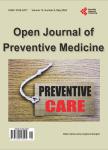Common Preventable Health and Social Problems Encountered by Elderly in Shinyanga Region in the Northern Part of Tanzania
Common Preventable Health and Social Problems Encountered by Elderly in Shinyanga Region in the Northern Part of Tanzania作者机构:School of Public Health Catholic University of Health and Allied Sciences Bugando Area Mwanza Tanzania School of Pharmacy Catholic University of Health and Allied Sciences Bugando Area Mwanza Tanzania
出 版 物:《Open Journal of Preventive Medicine》 (预防医学期刊(英文))
年 卷 期:2016年第6卷第3期
页 面:115-123页
学科分类:1004[医学-公共卫生与预防医学(可授医学、理学学位)] 100401[医学-流行病与卫生统计学] 10[医学]
主 题:Geriatric Social Problems Health Services Preventable Diseases Tanzania
摘 要:Background: In Tanzania elders are respected as repositories of inherited wisdom, experienced and principal decision makers in the community. However, evidence shows that such repositories are no longer considered important in most societies. As a result elders are neglected with some mistreatment in terms of provision of health and social services for instance;at times they get denied and ignored of their obvious rights, ignoring their retirement benefits and the rights onto free social services as per the Tanzania National Ageing Policy of 2003. Elders are therefore faced with physical, psychological and geriatric social suffering. It is on this basis that this study tries to explore the common preventable health and social problems encountered by elderly in Shinyanga Region in northern part of Tanzania. Methods: Across sectional community based study of 465 subjects randomly selected was done in three wards of Kahama District. The district was selected randomly out of 8 districts of Shinyanga Region, structured questionnaires with both closed and opened endower used;the information was collected from house to house and other information collected from health facilities within the wards as every ward had one public health facility;subjects (respondents) were obtained using purposive sampling technique aiming at elderly with 60 years of age and above. Results: Kahama district has a population of approximately 36,014 of which 1500 (4%) are in the elderly age group of 60 years and above. The study population was 465 which is 30% (465/1500) of the geriatric population of Kahama. Among this group 5% were female while 41% were male and 53% (248/465) were married. 64% (297/465) were taking care of themselves, 32% (150/465) cared by relatives and 4% (18/465) cared by the community. Among the respondents, 40% (185/465) were affected by HIV/AIDs in one way or another either living with orphans whose parents died of HIV/AIDS or asking care of the infected patients within the



